 Continuing from yesterday: This is a view of southwestern OKC from the Portland Avenue bridge over the Oklahoma River (AKA a highly developed section of the North Canadian River where it runs through OKC).
Continuing from yesterday: This is a view of southwestern OKC from the Portland Avenue bridge over the Oklahoma River (AKA a highly developed section of the North Canadian River where it runs through OKC).
The thing about a folding bike is the necessity of smaller wheel diameter. Mine features 20-inch wheels. While the typical high-end bearings and axles aren’t offered at that size, there is a different advantage altogether: smaller diameter wheels are far less fragile. Spokes don’t break as often, and everyone who rides folding bikes will affirm that they’ve never had a wheel go out of alignment (called “true” in bicycle technology).
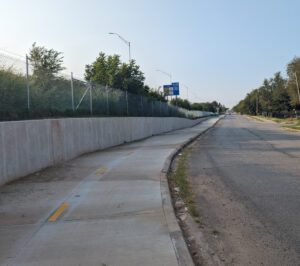 OKC continues to upgrade or build new bikeways throughout the city. This one runs right along Interstate 44 as part of the Grand Boulevard Trail. They did a lot of work to clean up and widen a former sidewalk that was just a temporary answer to a rather sudden rise in recreational bicycle traffic since the 1990s. While this makes it more comfortable for conventional bicycles, and now a large number of three-wheeled recumbents, it’s just huge on a folding bike. When switching to a folding bike, riders call it “squirrely” but that’s just another word for “responsive” once you get used to it.
OKC continues to upgrade or build new bikeways throughout the city. This one runs right along Interstate 44 as part of the Grand Boulevard Trail. They did a lot of work to clean up and widen a former sidewalk that was just a temporary answer to a rather sudden rise in recreational bicycle traffic since the 1990s. While this makes it more comfortable for conventional bicycles, and now a large number of three-wheeled recumbents, it’s just huge on a folding bike. When switching to a folding bike, riders call it “squirrely” but that’s just another word for “responsive” once you get used to it.
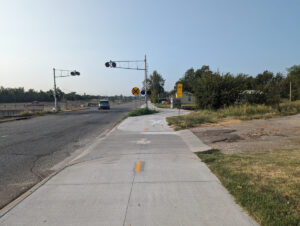 The engineers are giving thought to the implications of higher traffic loads for these bikeways. Here we see what was once an impossible obstacle smoothed out. Trains still use that track, unlike others in the city that have been decommissioned but not removed (the railroads are notoriously resistant to removal), so it has to work for both. The bikeway is now much better than the motor vehicle crossing. Previously I had to ride some very rough asphalt through here.
The engineers are giving thought to the implications of higher traffic loads for these bikeways. Here we see what was once an impossible obstacle smoothed out. Trains still use that track, unlike others in the city that have been decommissioned but not removed (the railroads are notoriously resistant to removal), so it has to work for both. The bikeway is now much better than the motor vehicle crossing. Previously I had to ride some very rough asphalt through here.
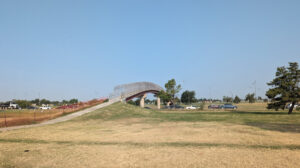 Last year’s model of the Zizzo Forte suffered a lot of complaints from users for cheap components that didn’t mesh well. This year’s model has 1×8 gears, and the front chainring is the right size. I don’t use 7th or 8th much, but I was able to ride over this steep arch in 2nd with comfort. I mostly run in either 5th or 6th, which indicates a good balance. I don’t need more gears. This is the bikeway overpass on Interstate 44, which cuts through a very old city park. The arch joins the two halves.
Last year’s model of the Zizzo Forte suffered a lot of complaints from users for cheap components that didn’t mesh well. This year’s model has 1×8 gears, and the front chainring is the right size. I don’t use 7th or 8th much, but I was able to ride over this steep arch in 2nd with comfort. I mostly run in either 5th or 6th, which indicates a good balance. I don’t need more gears. This is the bikeway overpass on Interstate 44, which cuts through a very old city park. The arch joins the two halves.
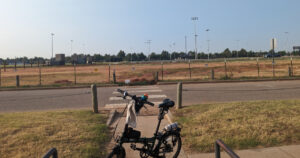 It’s called Woodson Park. The bikeway is supposed to run through that area, but for almost a year now it has been under reconstruction. All the pavement and facilities — rather substantial previously — were ripped out and everything is being rebuilt new. While it was like many other parks around the turn of the century as a center of gang activity, the city has done a good job of reclaiming that turf for the public. It was already pretty safe; now it’s going to be a lot nicer. Meanwhile, it’s a lot easier taking the various ad hoc detours on this bike than it was on the old one.
It’s called Woodson Park. The bikeway is supposed to run through that area, but for almost a year now it has been under reconstruction. All the pavement and facilities — rather substantial previously — were ripped out and everything is being rebuilt new. While it was like many other parks around the turn of the century as a center of gang activity, the city has done a good job of reclaiming that turf for the public. It was already pretty safe; now it’s going to be a lot nicer. Meanwhile, it’s a lot easier taking the various ad hoc detours on this bike than it was on the old one.
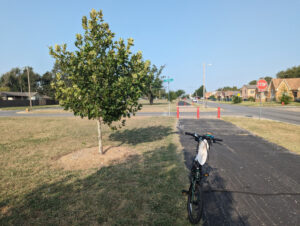 This is a view of the Grand Boulevard Trail in southeastern Capitol Hill area. The smaller wheels, lower center of gravity and shorter frame make this thing very easy to dodge around obstacles. On a regular bike, there were places where I was extra careful because the high center of gravity found me often rolling not exactly where I wanted to go. This bike allows me good comfort in close passage of bollards, sharp turns for badly engineered sidewalk ramps, broken pavement, etc.
This is a view of the Grand Boulevard Trail in southeastern Capitol Hill area. The smaller wheels, lower center of gravity and shorter frame make this thing very easy to dodge around obstacles. On a regular bike, there were places where I was extra careful because the high center of gravity found me often rolling not exactly where I wanted to go. This bike allows me good comfort in close passage of bollards, sharp turns for badly engineered sidewalk ramps, broken pavement, etc.
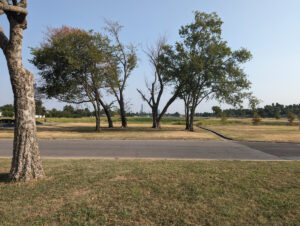 I’ve always loved this view. Some years ago I surveyed Lightning Creek. It’s always been a safety issue in OKC because of the vast amount of paved surface that feeds this creek. It’s notorious for flash flooding in storms, even brief ones. This is Oliver Park, which hosts one of three major catchment basins for Lightning Creek to give floodwaters a place to go. Just beyond the foreground trees is a five acre basin about eight or ten feet deep, and as the third basin on the watercourse, it still gets nearly full during storms, to the point the streets on the far side are still underwater at times. But the OKC skyline is beautiful from this angle.
I’ve always loved this view. Some years ago I surveyed Lightning Creek. It’s always been a safety issue in OKC because of the vast amount of paved surface that feeds this creek. It’s notorious for flash flooding in storms, even brief ones. This is Oliver Park, which hosts one of three major catchment basins for Lightning Creek to give floodwaters a place to go. Just beyond the foreground trees is a five acre basin about eight or ten feet deep, and as the third basin on the watercourse, it still gets nearly full during storms, to the point the streets on the far side are still underwater at times. But the OKC skyline is beautiful from this angle.
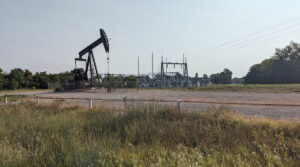 Farther along the Grand Boulevard Trail, over near the suburb of Del City, this image juxtaposes two structures that represent roughly half of Oklahoma’s whole economy: energy. If it’s not liquid petroleum, it’s electricity from natural gas. We export a lot of all three to other states. We still have active oil and gas wells in some of the oddest places, including right up next to state government offices, and even the Governor’s Mansion in OKC.
Farther along the Grand Boulevard Trail, over near the suburb of Del City, this image juxtaposes two structures that represent roughly half of Oklahoma’s whole economy: energy. If it’s not liquid petroleum, it’s electricity from natural gas. We export a lot of all three to other states. We still have active oil and gas wells in some of the oddest places, including right up next to state government offices, and even the Governor’s Mansion in OKC.


The causeway from the previous post (I can’t comment on it for some reason) looks pretty big, judging by the tanker driving on it. We have lots of impressive bridges like that here in Pittsburgh because of all the hills and rivers, and that one looks like it would be right at home here.
The only place we have anything that high is where the Interstate highways converge. It’s not the terrain itself compelling the stilts.